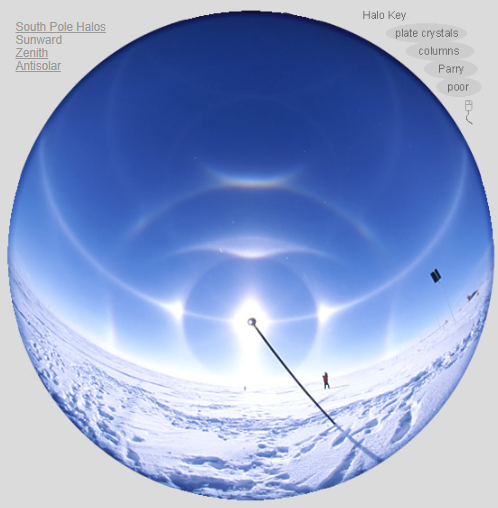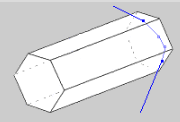South Pole Halos - Sunwards
South Pole Halos - Sunwards
At the South Pole on January 11th, 1999, an incredible atmospheric phenomenon occurred. The sun, in its continuous circular path, illuminated the snow and ice of the polar plateau at an altitude of approximately 22º. This mesmerizing sight was captured by Marko Riikonen's fisheye lens, which provided a panoramic view spanning 180º, encompassing the zenith and half of the horizon.
The breathtaking display of halos was caused by low-level diamond dust ice crystals present in the atmosphere. These crystals, consisting of plate and column shapes, created a stunning array of optical effects. Interestingly, all crystal orientations were observed except for the Lowitz orientation, making this occurrence even more unique.
In more temperate skies, halos are often viewed individually. However, at the South Pole, these halos blazed together with unprecedented brilliance. A prominent 22º halo encircled the sun, accompanied by an upper tangent arc positioned above it. Additionally, a circumzenithal arc shone brightly above these formations, while sundogs adorned a complete parhelic circle.
Beyond the 22º halo, twice as far from the sun, lay two rare arcs known as supralateral and infralateral arcs. These arcs, along with an intense suncave Parry arc atop the upper tangent arc, added to the enchanting spectacle. A faintly visible 46º halo appeared near the parhelic circle, where it was less obscured by brighter arcs.
For halo enthusiasts, the true treasures were the exceptionally rare arcs that were visible in unison at the South Pole. These included the Parry supra- and infralateral arcs, also known as Tape arcs. These arcs were formed by rays passing between the end and sloping side faces of Parry-oriented crystals. Similar ray paths give rise to 'ordinary' supra- and infralateral arcs in singly oriented columns.
One notable feature captured in the images is the thin diagonal cross extending from the sun towards the zenith. This striking formation is known as a heliac arc, which requires sunlight to reflect precisely from the external and sometimes internal faces of crystals with Parry orientations.
Tangential to the heliac arc, at its furthest extension, lies the antisolar arc, also referred to as the subanthelic arc. This arc is formed by precisely oriented Parry columns of exceptional optical quality. The rays follow a similar path to that of the heliac arc but also involve an additional internal reflection off an end face. R.A.R. Tricker first explained this captivating arc in 1979.
The images accompanying this article offer a glimpse into the extraordinary atmospheric optics observed at the South Pole. While some arcs are better visible in other views, they highlight the presence of additional rare arcs such as the subhelic, Wegener, and Hastings arcs.
The beauty and complexity of these atmospheric phenomena continue to captivate scientists and enthusiasts alike. Studying these halos and arcs provides valuable insights into the behavior of light and the intricate nature of ice crystals in our atmosphere. The South Pole, with its unique conditions, offers an exceptional vantage point to witness these awe-inspiring displays of natural artistry.

South Pole 11th January 1999.
The sun circles the snow and ice of the polar plateau at a near constant altitude of 22º.
Marko Riikonen's fisheye lens view is 180º wide encompassing the zenith and half the horizon.
Mouse over the "Halo key" to identify the halos.
Low level diamond dust ice crystals produce the halos; some nearby crystals show up as specks and streaks. The crystals are plate and column shaped. All orientations are present with the notable exception of that of Lowitz.
Halos frequently viewed singly in more temperate skies blaze all together with unacustomed brilliance. A 22º halo circles the sun, topped by an upper tangent arc. Well above that shines a circumzenithal arc. Bright sundogs lie on a complete parhelic circle.
Twice as far from the sun as the 22º halo lie the rare supralateral and infralateral arcs. Atop the upper tangent arc is an intense suncave Parry arc.
A 46º halo shows faintly near the parhelic circle where it is less obscured by brighter arcs.
But for halo hunters, the real gems are the very rare arcs here visible all together. The brightenings on the supralateral and infralateral arcs are Parry supra- and infralateral arcs made by rays passing between the end and sloping side faces of Parry oriented crystals. These are the same ray paths that in singly oriented columns form 'ordinary' supra- and infralateral arcs. The arcs are alternatively known as Tape arcs.
The thin diagonal cross through the sun and extending high towards the zenith is a heliac arc. To make it, sunlight has to reflect from the external (and sometimes the internal) faces of crystals with exquisitely precise Parry orientations.
Tangential to the heliac arc at its furthermost extension is the antisolar arc (also called the subanthelic arc), formed by precisely oriented Parry columns of superb optical quality.
Some very rare arcs (subhelic, Wegener, Hastings) labelled on this image are better visible on other views and are described there. And those views show other rare arcs too.

Heliac arc
Rays in the blue path reflect externally from the lower slanting side face of a Parry oriented crystal. In the second, purple path rays enter the uppermost horizontal face, reflect internally from an upward slanting side face and then leave through a downward slanting side face.

Antisolar arc (subanthelic arc)
Rays follow the same path as that of the purple heliac arc ray but there is an additional internal reflection off an end face. Other much more complicated ray paths also form this arc. The arc passes through the antisolar point and was first explained by R.A.R. Tricker in 1979.
Note: this article has been automatically converted from the old site and may not appear as intended. You can find the original article here.
Reference Atmospheric Optics
If you use any of the definitions, information, or data presented on Atmospheric Optics, please copy the link or reference below to properly credit us as the reference source. Thank you!
-
<a href="https://atoptics.co.uk/blog/south-pole-halos-sunwards/">South Pole Halos - Sunwards</a>
-
"South Pole Halos - Sunwards". Atmospheric Optics. Accessed on November 26, 2024. https://atoptics.co.uk/blog/south-pole-halos-sunwards/.
-
"South Pole Halos - Sunwards". Atmospheric Optics, https://atoptics.co.uk/blog/south-pole-halos-sunwards/. Accessed 26 November, 2024
-
South Pole Halos - Sunwards. Atmospheric Optics. Retrieved from https://atoptics.co.uk/blog/south-pole-halos-sunwards/.